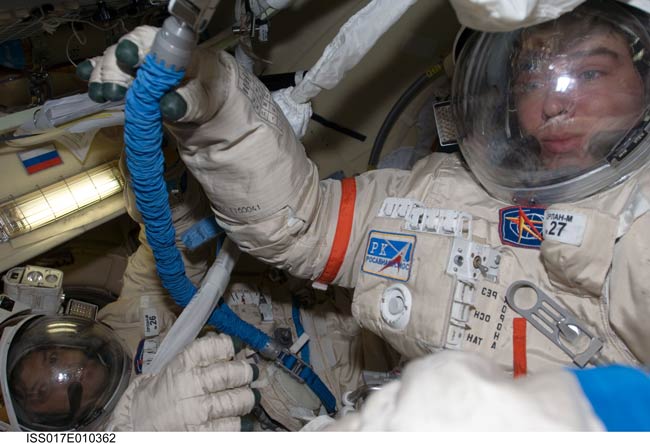Astronauts to Install Docking Target on Space Station

Two Russian cosmonauts plan to install a docking target andswap out science experiments during a Tuesday spacewalk outside theInternational Space Station.
The five-and-a-half hour spacewalk is set for 1:08 p.m. EDT (1708GMT), as the second of two spacewalks conducted by space station commanderSergei Volkov and flight engineer Oleg Kononenko.
Both cosmonauts were first-time spacewalkers when theysuccessfully removedan explosive bolt from the Russian Soyuz spacecraft outside the spacestation on July 10. The six-hour,18 minute spacewalk was added per Russian request as part of the continuinginvestigation into a mysterious malfunction that has caused the two most recentSoyuz spacecraft to go off-courseduring re-entry.
The second spacewalk will focus on the original duties forthe initial spacewalk that were pushed back to allow for the Soyuz inspection,NASA officials said at a press briefing July 8.
Those duties include placing the docking target for anupcoming mission, removing a biological experiment and putting a high-energyphysics experiment in place. Russian mission controllers had hoped that thecosmonauts could install the docking target on the space station?s Zvezdamodule during the July 10 spacewalk, but eventually opted to give Volkov andKononenko a break.
The second spacewalk will start off with Volkov andKononenko placing the dockingtarget for a new airlock called the Mini-Research Module 2 (MRM2). Thatwill replace the Pirs docking compartment as the main airlock for the Russianpart of the space station, after its delivery in 2009 by an unmanned RussianProgress spacecraft.
Both spacewalks have required the cosmonauts to exit fromthe Pirs docking compartment, which also represents the only passage betweenthe space station and the Soyuz spacecraft that serves as an emergency lifeboat.U.S. astronaut GregChamitoff will once again spend the entire spacewalk sitting inside of theSoyuz, so that he does not get cut off in the unlikely event of a crisis.
Breaking space news, the latest updates on rocket launches, skywatching events and more!
Kononenko will install the docking target by riding the longarm of the Strela hand-powered crane to the Zvezda module. Volkov will operatethe hand-powered crane and move his fellow astronaut to the target location.
Next, the cosmonauts will use a spacewalker?s ladder andmove to a different part of Zvezda to inspect some bolt holes. The holes willserve as the location for a future antenna adapter that will serve the Kursautomated docking system.
A quick trip back to Pirs should allow the cosmonauts to getthe Vsplesk, also known as Burst, experiment and install it on the Russianmodule. Burst will gauge the seismic effects of high energy particle streams inorbit around the earth.
Lastly, Volkov and Kononenko aim to retrieve the Bioriskexperiment installed by Expedition 15 spacewalkers on the Russian module. Thatlong-running experiment looks at the effects of solar radiation and zero G onmicrobes and other small organisms.
Volkov will wear the Orlan spacesuit with red stripes aslead spacewalker (EV1), while Kononenko will wear a blue-striped suit (EV2).
- New Video: Dangerous Spacewalk: Handling Explosives
- New Video: Hurricane Bertha: View from a Million Feet
- New Video: Flame Trench Repair
Jeremy Hsu is science writer based in New York City whose work has appeared in Scientific American, Discovery Magazine, Backchannel, Wired.com and IEEE Spectrum, among others. He joined the Space.com and Live Science teams in 2010 as a Senior Writer and is currently the Editor-in-Chief of Indicate Media. Jeremy studied history and sociology of science at the University of Pennsylvania, and earned a master's degree in journalism from the NYU Science, Health and Environmental Reporting Program. You can find Jeremy's latest project on Twitter.
